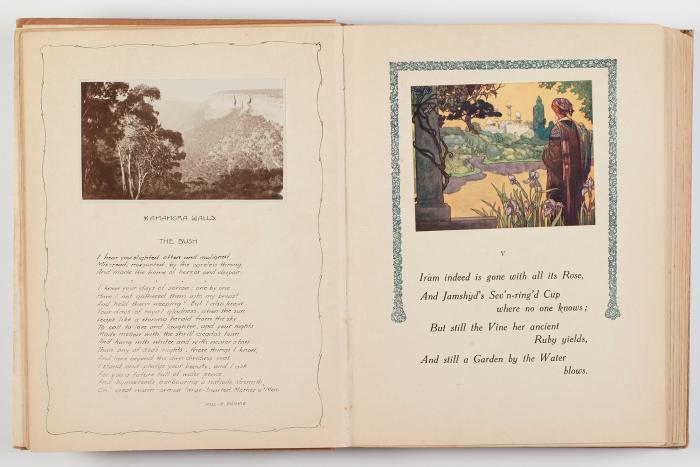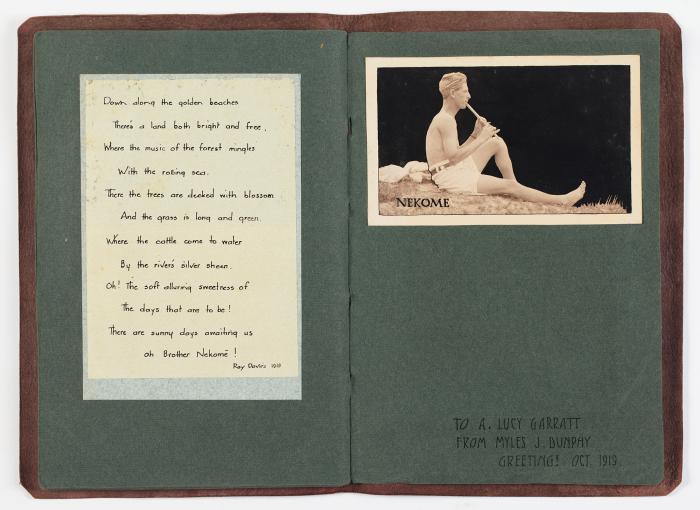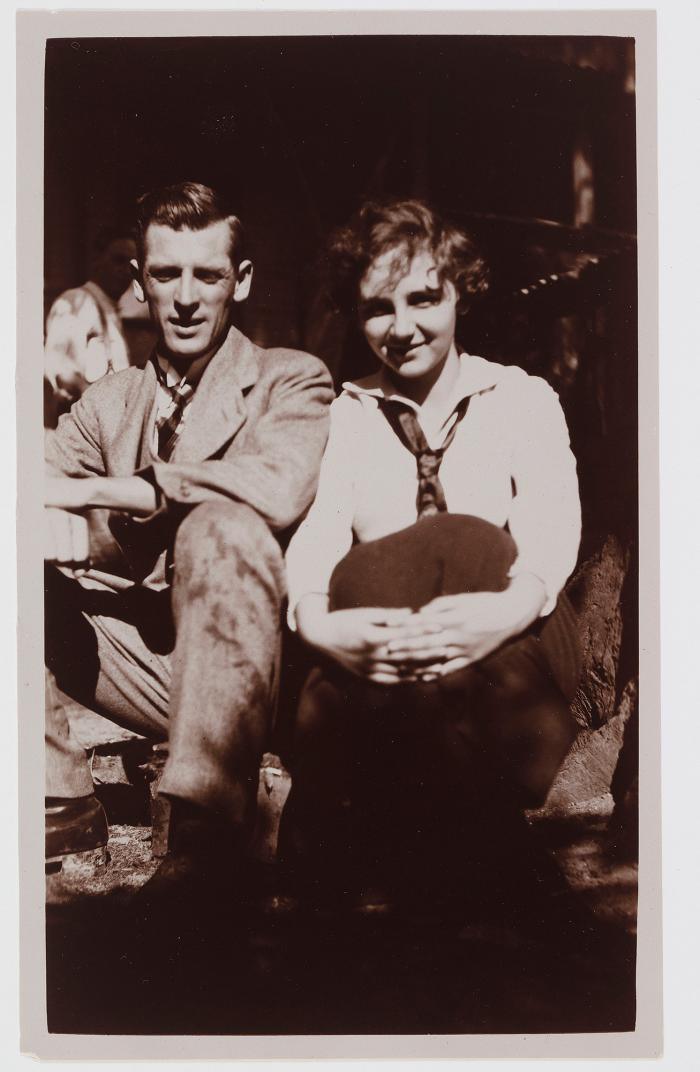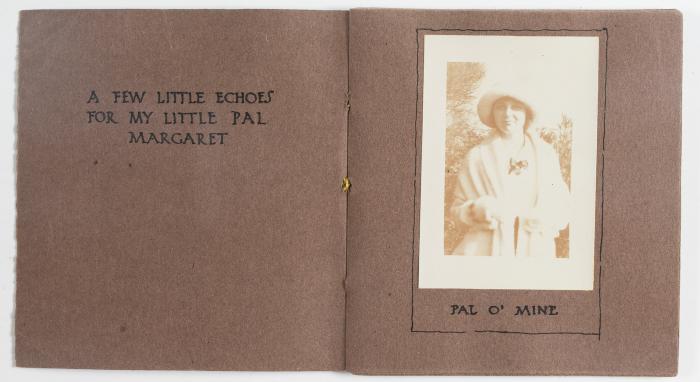‘My friends,’ wrote Myles Dunphy in 1920, ‘the aim and purpose of life is love’.
The renowned conservationist, mapmaker, architect and teacher went on to argue, in his essay ‘To Wait or Not to Wait?’, that a man should not wait to marry until he is ‘of means’. He should seize the opportunity when it arises to wed the woman he loves.
Dunphy composed this essay — a draft is in the Library’s collection — after an argument with a friend around the fire on a Sunday night. To strengthen his point he quotes American orator Robert Ingersoll, the Sanskrit text Hitopadesha, Tamil poet Thiruvalluvar and Australian author Zora Cross (‘Love — love is all; and sweeps in mighty flood’).
It’s not surprising that Dunphy took this romantic view, having lost his fiancée Hazel Matheson to tuberculosis in 1916. ‘[L]ife is too tragically uncertain,’ he writes. ‘There is no time for ample preparations. Do the best you can, seize everything within your rightful power to grasp, and the greatest of all is love.’
Many people know of Myles Dunphy’s tireless commitment to the conservation movement in NSW — including his successful lobbying for the Blue Mountains to be listed as a national park. His richly illustrated journals and other papers bequeathed to the Library in 1985 document his life of bushwalking and mapmaking (some of the journals featured in the Library’s 2018 exhibition UNESCO Six).
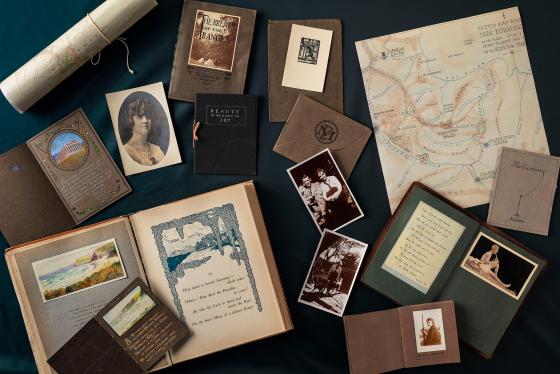
A key item in the new collection is a grangerised copy (with added illustrations and text) of a 1913 edition of the Rubaiyat of Omar Khayyam, first published in English in 1859. Dunphy addressed the book to ‘Girl Dorothy’ in 1917, hand-colouring existing illustrations (by Rene Bull) and adding watercolour paintings, photographs, aphorisms and poems by himself and others (including Will H Ogilvie, George Essex Evans and Ada Cambridge). The images feature bushwalking destinations such Garie Beach in the Royal National Park and Hollanders River in the Central Tablelands, and one photograph shows Dunphy in bushwalking gear looking out from atop a rock ledge.
Dunphy’s selected poems circle around his favourite themes: the pursuit of love and beauty, awe of nature, the joy of camping, and a patriotic view of Australia. The book finishes with a handwritten inscription:
Myles to Dorothy. Con Amore [with love].
This book had a remarkable journey from its recipient to Myles’ son Dexter. When Dorothy died in 1967, it was among her treasured possessions. As she didn’t have any living relatives, a nursing home staff member gave it to her own son, who was then a young bookseller. About 10 years ago, the bookseller attempted to find contact details for Myles Dunphy using Google, but didn’t have any luck. He tried again last year, found Dexter Dunphy, and gave him the book. Whether Dorothy was a girlfriend of Myles, or just a girl he admired, we don’t know. It’s clear, though, that he put a great deal of time and skill into the book’s production — it contains some 35 poems in Dunphy’s varied calligraphic styles.
Another set of booklets lovingly created by Myles Dunphy came to the Library in 2003. The leather-covered ‘Book of Nekome’ (Dunphy’s pseudonym) and ‘The Breath of the Ranges’ are dedicated to Ada Lucy Garratt in 1919 and 1920, the first embossed with her initials ‘ALG’. They were donated by Ada’s daughter Mrs B De’Maid-Groves, who said that her mother had treasured them throughout her life.
They feature hand-copied verses by Dorothea Mackellar, Charles Wagner, Banjo Paterson and others, and photographs taken by Myles of scenery and campsites at Kanangra, Kowmung and other remote locations. They are dedicated to Ada ‘in friendship’.
By 1922, Dunphy had begun a relationship with Margaret Peet, who he would marry in 1925. Dunphy’s loving devotion to Margaret can be seen in the recently acquired cards and booklets, which also detail his (or Nekome’s) thoughts on beauty and nature. One booklet illustrates Victor Daley’s poem ‘The Little Worlds’ with watercolour drawings of Coxs River, Middle Harbour and other places in NSW. Another, ‘The Tidgy Outdoor Book’, is dedicated to Margaret (his ‘little pal’) in 1923, and features a series of photographs of her with pithy captions, alongside tiny cartoons of canoeing and camping adventures. Dunphy’s booklets are all carefully crafted, with immaculate hand-stitched bindings.
In 1920, when Dunphy was 29 and single, he wrote that ‘A man’s greatest asset is almost invariably his wife’, and it appears he dedicated much attention to searching for a happy union. Marrying at 34, he remained devoted to Margaret for the 60 years until his death in 1985. With their sons Milo and Dexter, the couple enjoyed regular camping trips in remote parts of NSW.
The extensive Myles Dunphy collection in the Library shows us his artistic and technical skill through fastidiously drawn maps and illustrated journals. The latest acquisition adds to our understanding of a man who valued drawing and poetry as essential elements of love and romance.
Anna Corkhill
Curator, Research & Discovery

